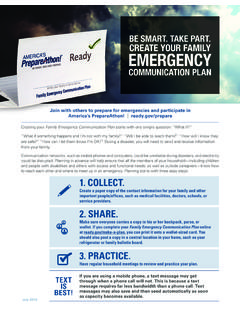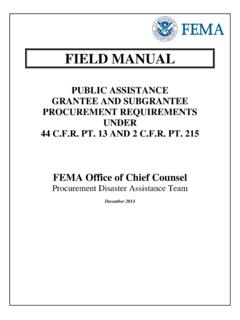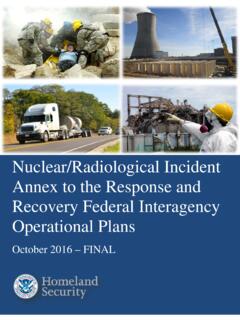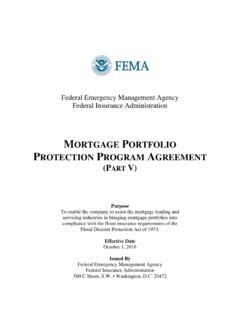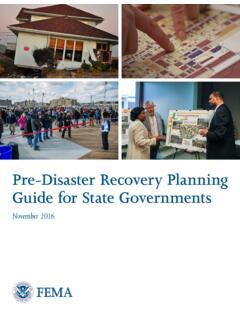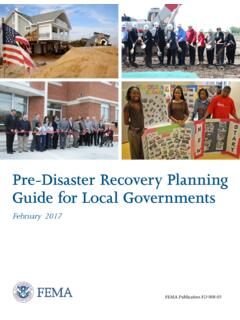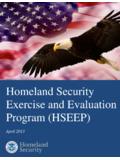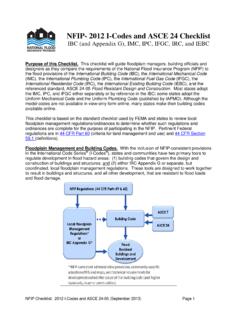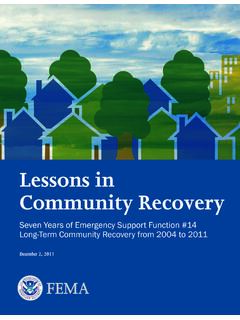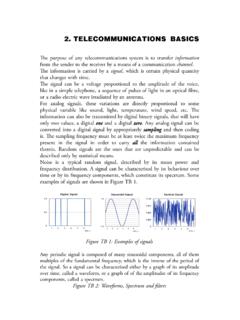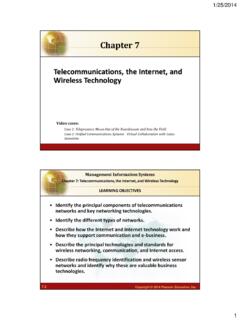Transcription of ESF 2 - Communications Annex
1 Emergency Support Function #2 Communications Annex January 2008 ESF #2 Communications Annex ESF #2-1 ESF Coordinator: Department of Homeland Security/National Protection and Programs/Cybersecurity and Communications /National Communications System Primary Agencies: Department of Homeland Security/National Protection and Programs/Cybersecurity and Communications /National Communications System Department of Homeland Security/Federal Emergency Management Agency Support Agencies: Department of Agriculture Department of Commerce Department of Defense Department of Homeland Security Department of the Interior Federal Communications Commission General Services Administration INTRODUCTION Purpose Emergency Support Function (ESF) #2 Communications supports the restoration of the Communications infrastructure, facilitates the recovery of systems and applications from cyber attacks, and coordinates Federal Communications support to response efforts during incidents requiring a coordinated Federal response (hereafter referred to as incidents ).
2 This ESF implements the provisions of the Office of Science and Technology Policy (OSTP) National Plan for Telecommunications Support in Non-Wartime Emergencies (NPTS). ESF #2 also provides Communications support to Federal, State, tribal, and local governments and first responders when their systems have been impacted, and provides Communications and information technology (IT) support to the Joint Field Office (JFO) and JFO field teams. With the rapid convergence of Communications and IT, the National Communications System (NCS) and the National Cyber Security Division (NCSD) work closely to coordinate the ESF #2 response to cyber incidents.
3 This convergence requires increased synchronization of effort and capabilities between the Communications and IT sectors to facilitate ESF #2 s ability to respond to all types of incidents. Scope ESF #2 coordinates Federal actions to assist industry in restoring the public Communications infrastructure and to assist State, tribal, and local governments with emergency Communications and restoration of public safety Communications systems and first responder networks. ESF #2 supports Federal departments and agencies in procuring and coordinating National Security and Emergency Preparedness (NS/EP) Communications services. ESF #2 provides Communications support to the JFO and any JFO field teams.
4 ESF #2 also addresses cyber security issues that result from or occur in conjunction with incidents. However, for incidents that are primarily cyber in nature, the Cyber Incident Annex is used and ESF #2 supports responses to cyber incidents as directed. Emergency Support Function #2 Communications Annex ESF #2-2 ESF #2 Communications Annex January 2008 Policies Section 706 of the Communications Act of 1934, as amended (47 606), establishes Presidential powers during wartime emergencies for priority use of the national Communications infrastructure. Executive Order 12472 assigns authority to the Director, OSTP, to direct the exercise of the war power functions of the President under 706(a), (c) (e), of the Communications Act of 1934, as amended (47 606), should the President issue implementing instructions in accordance with the National Emergencies Act (50 1601).
5 Executive Order 12472 also assigns specific non-wartime emergency Communications authorities to the Director, OSTP. The NPTS serves as the basis for planning the use of national Communications assets and resources in support of non-wartime emergencies, as defined by Executive Order 12472. The NPTS is applicable to all Federal departments, agencies, and other organizations in accordance with Executive Order 12472 and other national policies. An OSTP memorandum to the Manager, NCS, dated June 11, 1993, Subject: NS/EP Telecommunications, states that the Office of the Manager, NCS, executes Federal Response Plan primary agency functional responsibilities on behalf of OSTP.
6 This delegation of authority is retained in the National Response Framework. Furthermore, OSTP delegates ESF #2 coordinator functional responsibilities to the Office of the Manager, NCS. The Cyber Incident Annex outlines the provision of Federal cyber incident response coordination among the Federal departments and agencies and, upon request, State, tribal, local, and private-sector entities in response to any incident induced by cyber means ( , significant cyber events, technological emergencies, and Presidentially declared major disasters and emergencies that threaten, disrupt, or cripple Communications and IT services or degrade other essential infrastructures).
7 The Homeland Security Act of 2002, as amended by the Post-Katrina Emergency Management Reform Act, establishes an Office of Emergency Communications within the Department of Homeland Security (DHS). In cooperation with the NCS, this office is responsible for coordinating the establishment of a national response capability with initial and ongoing planning, implementation, and training for the deployment of Communications equipment for relevant State, tribal, and local governments and emergency response providers in the event of a catastrophic loss of local and regional emergency Communications services. CONCEPT OF OPERATIONS General DHS/Federal Emergency Management Agency (FEMA) activates ESF #2 when a significant impact to the Communications infrastructure is expected or has occurred.
8 When activated, ESF #2 provides Communications support to the impacted area, as well as internally to the JFO and associated Federal JFO teams. ESF #2 support is scalable to meet the specific needs of each incident response, and response resources are drawn from a matrix of personnel and equipment available from the ESF #2 support agencies. Emergency Support Function #2 Communications Annex January 2008 ESF #2 Communications Annex ESF #2-3 Primary Agencies NCS y Acts as the ESF #2 coordinator. y Acts as the ESF #2 primary agency in accordance with the Memorandum from OSTP to the Manager, NCS, dated June 11, 1993, to include exercising primary responsibility for restoration of telecommunications in an incident area.
9 Y Establishes, in consultation with FEMA and other NCS member agencies, a cadre of qualified and appropriately trained personnel certified to serve as Federal Emergency Communications Coordinators (FECCs)/ Communications Branch Directors. y Coordinates the planning for and provision of NS/EP Communications for the Federal Government under all circumstances, including crisis or emergency, attack, recovery, and reconstitution, in accordance with Executive Order 12472. y Designates an FECC to lead ESF #2 when it is activated. Normally the NCS will confer with FEMA and the ESF #2 support agencies regarding the selection of the FECC from the cadre of FECC qualified personnel.
10 Y Coordinates with FEMA and support agencies to develop a program to certify FECCs. y Coordinates with FEMA and support agencies to develop training for the FECC cadre. y Monitors training for all ESF #2 team members. y Certifies personnel for inclusion in the FECC cadre. y Designates a team lead for a component responsible for Communications infrastructure restoration functions. y Coordinates the restoration of Communications infrastructure and supports Federal departments and agencies in procuring and coordinating NS/EP Communications services when the component responsible for Communications infrastructure restoration functions becomes operational.
